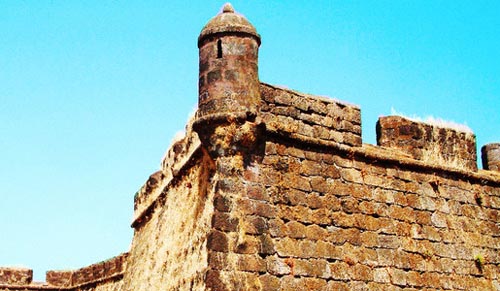Khorjuve Fortress

Information on Khorjuve Fortress (Goa) - History & Architecture
Located within the distance of about 4 kilometre from Aldona of Goa, Khorjuve or Corjuem is an island where Khorjuve Fortress is based. The fortress was constructed in 1551 by Bhonsles rulers and it is quite small in comparison with other fortress of Goa. Irrespective of the size, Khorjuve Fortress provide great sight of the nearby river and land. The dimension of the fort opposes its strategic significance in Goa's history.
Khorjuve Fortress Architecture
Khorjuve is a quite scenic island which was named according to Moreno de Souza, a Goan Jesuit priest. There are various temples along with a school, club and healthcare centre in the island. The key attraction of the island is Khorjuve Fortress, a square shaped architecture with extensive walls. During 16th century the fortress was believed to act as a defence centre. Thus, it has various shooter points and assassination holes. At every corner of Khorjuve Fortress, there is a ramp based staircase which directs to the stockades. The fortress possesses a well along with three residential quarters. Inside the fortress there is also a small sanctuary which is dedicated to 'Mae de Deus' also known as 'Mother of God'. This sanctuary appears to an addition of the actual structure of the fortress. It was created under the provincial church of Aldona in the year 1854 by Joao Felipe. There is also a temple in Khorjuve Fortress which is also known as 'Sateri Panchayatan Temple'. Khorjuve Fortress has the discrepancy of being one of the only two fortresses which have survived in Goa.
Khorjuve Fortress is quite attractive due to its location. It is enclosed by lavish greenery and one can obtain complete view of striking villages and the neighbouring islands from the fortress. The fortress is created from pitted laterite stones. The island where the fort is situated is connected with Aldona through a cable suspension channel which is also a key source of magnetism. Although various other structures of the fortress are vanished, the walls along with other important structures are in good condition without significant maintenance work.
Khorjuve Fortress History
The initial occupants of Khorjuve Fortress were Bhonsles rulers. At later phase, Portuguese occupied the fort and used it in order to defend themselves from the invasion of Rajput, Maratha and Bhonsles. Under the command of Portuguese viceroy, the fortress was subsequently recreated in order to enhance the security in Panaji. During the period of early 1800s, the fortress was utilised as a military training institution.
Khorjuve Fortress also has an interesting historical incident related with Portuguese military. It was said that one of the defenders of the fortress was a determined Portuguese female namely Ursula e Lancastre. She landed up in Khorjuve Fortress as a combatant because she was quite determined to flourish in man's domain. She even make herself to appear like male and eventually served like a soldier and travelled the world. However, in the end she was caught and uncovered. But that did not finished her military profession and eventually she turned up marrying the captain of the fortress inside the area.
Khorjuve Fortress Tourism Importance
Khorjuve Fortress can provide travellers with a mixture of beauty as well as improbable artwork. As one of the surviving fortresses in Goa, Khorjuve Fortress certainly have great importance with respect to tourism. It is located in beautiful island where travellers can enjoy the original natural magnificence of the fortress. Furthermore, the architecture of the fort also has definite appeal for the visitors.
- Andaman Nicobar Monuments
- Andhra Pradesh Monuments
- Assam Monuments
- Bihar Monuments
- Chhattisgarh Monuments
- New Delhi Monuments
- Goa Monuments
- Gujarat Monuments
- Haryana Monuments
- Himachal Pradesh Monuments
- Jammu and Kashmir Monuments
- Karnataka Monuments
- Kerala Monuments
- Madhya Pradesh Monuments
- Maharashtra Monuments
- Odisha Monuments
- Punjab Monuments
- Rajasthan Monuments
- Tamil Nadu Monuments
- Telangana Monuments
- Uttar Pradesh Monuments
- West Bengal Monuments